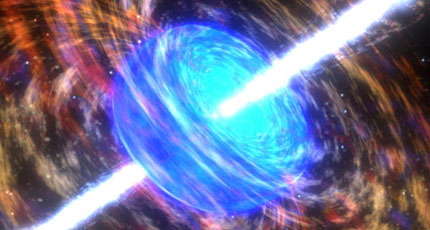News
- Tania Altamirano López
LAGO: A high altitude and energy community
ExpiredHigh-altitude zones with privileged skies for Astrophysics and a dedicated team of researchers are the elements of LAGOa, a community that is part of the COMCLARA 2010 Programme which works on the development of a large aperture observatory for the study of gamma ray bursts which hit the Earth, and on the development of data repositories through virtual collaboration environments over RedCLARA.

Observing the high-energy part of gamma ray bursts when they reach the ground and measuring solar activity through the modulation produced over the flow of galactic cosmic rays; these are the goals of LAGO (Large Aperture Gamma Ray Burst Observatory), a community constituted by 59 members from 21 institutions and 11 countries who have accomplished the beginning of activities in Argentina, Bolivia, Peru, Colombia, Mexico and Venezuela, and the installation of operational detectors recording data in Mexico, Bolivia, Peru and Argentina.
“In 2004 we conducted a study through which we discovered that the 1.600 Pierre Auger detectors used in Geiger mode, at an altitude of 1.400m were as sensitive to gamma ray bursts as the detectors in the Chaclataya observatory (Bolivia), which being located at 5.300m served as a referent”, indicates Xavier Bertou, leader and spokesman of the Collaboration of the Bariloche Atomic Centre in Argentina and coordinator of the LAGO Community.
According to Humberto Salazar Ibargüen, PhD in Physics, member of Meritorious Autonomous University of Puebla in Mexico and responsible for the LAGO site in Sierra Negra, one of the most outstanding aspects of LAGO is that it represents a competitive in imitative developed from Latin America, which makes the most out of the geographical conditions (excellent altitude) and expertise of several groups in working at high altitudes. “A second aspect is the reduced cost of the experiment, considering –again- its competitiveness, and finally the development of human resources, both in the technological and scientific areas, is another aspect to be highlighted”, states the expert.
Team and online work
Another fundamental element of the work done by this Community consists in the development of LAGO Virtual, a series of tools which make it possible to record, catalogue, protect and, above all, share the data obtained by the detectors installed.
“The difficulty with having detectors in many countries is that you have to gather the data of all the experiments, characterise them to subsequently be able to analyse them automatically. Then we needed a data and metadata base to manage them. Doing all this through a virtual platform has enabled us precisely to overcome the differences in the format for recording atmospheric pressure, for example. When you want to correlate the detector’s counting rate with pressure, you don’t need to know the specific format used by each site. Therefore, a virtual platform diplaying data in a unified way would enormously facilitate LAGO’s information management”, explains Bertou.
With the implementation of this initiative each member of the project has the chance to remotely access and control the equipment, conduct simulations of the detectors’ operation and protect, catalogue and share the data generated by each of the LAGO groups. Furthermore, it features a collaboration platform in real time (chat and videoconference) which enable the development of virtual meetings to organise seminars and work meetings with the other team members.
Currently, the data generated between the different LAGO centres are transferred through RedCLARA, and according to Bertou they amount to around 5 to 10 GB per month per site, depending on the quantity of detectors, an amount that turns out to be quite important considering their location and the sites’ connection difficulties. “We have to collect the data in one computing centre in order to be able to analyse them. These data usually consist in 4 counting rates every 5 milliseconds for each detector, which can be a lot to transfer between our countries, particularly when local networks do not feature a very high speed. Until now, the best solution was to carry the data in a hard disk to the LAGO annual workshop, but we are working to be able to communicate regularly through videoconference, share data and have a sort of virtual LAGO observatory where one can access all the data without having to worry about where they come from. In order to do all this we want to have the support of RedCLARA”, he concludes.
Gamma rays: Between the sky and the ground
Gamma radiation or gamma rays (γ) are a type of electromagnetic radiation produced by extremely energetic astrophysical phenomena; they occur in random positions of the sky and their origin still remains under scientific discussion. In any case, they seem to constitute the most energetic phenomena in the Universe.
In general, the GRBs produced in space do not reach the earth’s surface since they are absorbed by the atmosphere. The exceptions are those whose energy is above a few thousand gigaelectronvolts (or GeV) that by falling on the atmosphere produce thousands of particles (extensive atmospheric cascade) which are located in the Earth’s surface through detecting tanks that make it possible to see the Cherenkov radiation produced by them as they cross the water.
“The analysis of these GRBs is a great opportunity to study Astrophysics, Particle Physics and scientific instrumentation”, indicates Luis Otiniano, Researcher from the National Commission of Aerospace Research and Development, CONIDA, from Lima, Peru and member of the LAGO Community.




